Actors' Equity Association: History, Stage Management, and Impact
VerifiedAdded on 2023/04/19
|7
|1930
|220
Report
AI Summary
This report provides a detailed examination of the Actors' Equity Association (AEA), a significant labor union representing actors and stage managers in the American theater. The paper traces the AEA's historical development from its foundation in 1913, highlighting key milestones such as its affiliation with the American Federation of Labor and its impact on the working conditions and wages of theater professionals. It explores the union's role in negotiating contracts, advocating for better benefits, and its involvement in significant strikes that shaped the landscape of the theater industry. The report also discusses the AEA's influence on stage management practices and its broader impact on the arts and entertainment sector, including its political activities and support for various health reforms. The conclusion emphasizes the AEA's effectiveness in improving the management of acting and theatre in general, advocating for actors, and fostering the art of live theater as a valuable part of the community.
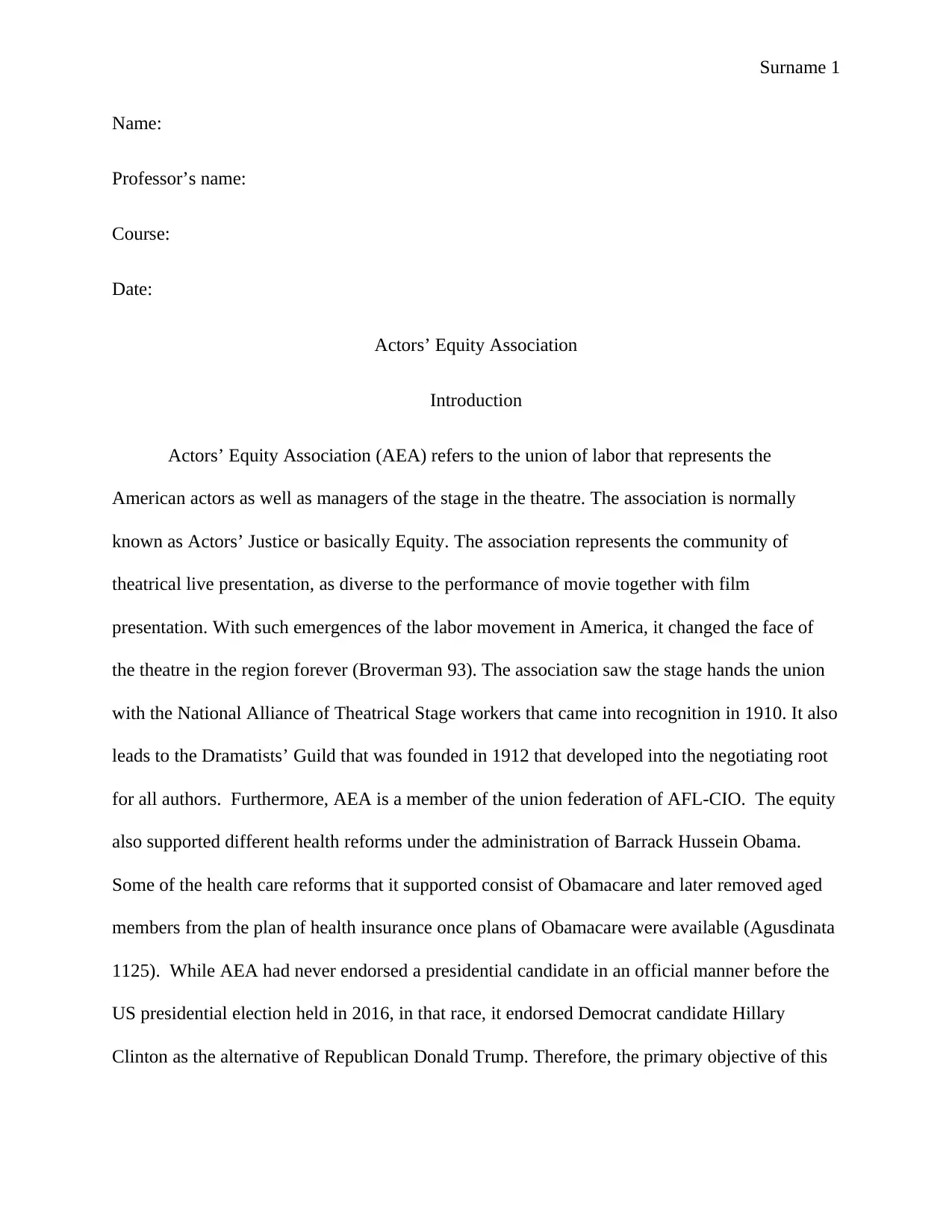
Surname 1
Name:
Professor’s name:
Course:
Date:
Actors’ Equity Association
Introduction
Actors’ Equity Association (AEA) refers to the union of labor that represents the
American actors as well as managers of the stage in the theatre. The association is normally
known as Actors’ Justice or basically Equity. The association represents the community of
theatrical live presentation, as diverse to the performance of movie together with film
presentation. With such emergences of the labor movement in America, it changed the face of
the theatre in the region forever (Broverman 93). The association saw the stage hands the union
with the National Alliance of Theatrical Stage workers that came into recognition in 1910. It also
leads to the Dramatists’ Guild that was founded in 1912 that developed into the negotiating root
for all authors. Furthermore, AEA is a member of the union federation of AFL-CIO. The equity
also supported different health reforms under the administration of Barrack Hussein Obama.
Some of the health care reforms that it supported consist of Obamacare and later removed aged
members from the plan of health insurance once plans of Obamacare were available (Agusdinata
1125). While AEA had never endorsed a presidential candidate in an official manner before the
US presidential election held in 2016, in that race, it endorsed Democrat candidate Hillary
Clinton as the alternative of Republican Donald Trump. Therefore, the primary objective of this
Name:
Professor’s name:
Course:
Date:
Actors’ Equity Association
Introduction
Actors’ Equity Association (AEA) refers to the union of labor that represents the
American actors as well as managers of the stage in the theatre. The association is normally
known as Actors’ Justice or basically Equity. The association represents the community of
theatrical live presentation, as diverse to the performance of movie together with film
presentation. With such emergences of the labor movement in America, it changed the face of
the theatre in the region forever (Broverman 93). The association saw the stage hands the union
with the National Alliance of Theatrical Stage workers that came into recognition in 1910. It also
leads to the Dramatists’ Guild that was founded in 1912 that developed into the negotiating root
for all authors. Furthermore, AEA is a member of the union federation of AFL-CIO. The equity
also supported different health reforms under the administration of Barrack Hussein Obama.
Some of the health care reforms that it supported consist of Obamacare and later removed aged
members from the plan of health insurance once plans of Obamacare were available (Agusdinata
1125). While AEA had never endorsed a presidential candidate in an official manner before the
US presidential election held in 2016, in that race, it endorsed Democrat candidate Hillary
Clinton as the alternative of Republican Donald Trump. Therefore, the primary objective of this
Paraphrase This Document
Need a fresh take? Get an instant paraphrase of this document with our AI Paraphraser
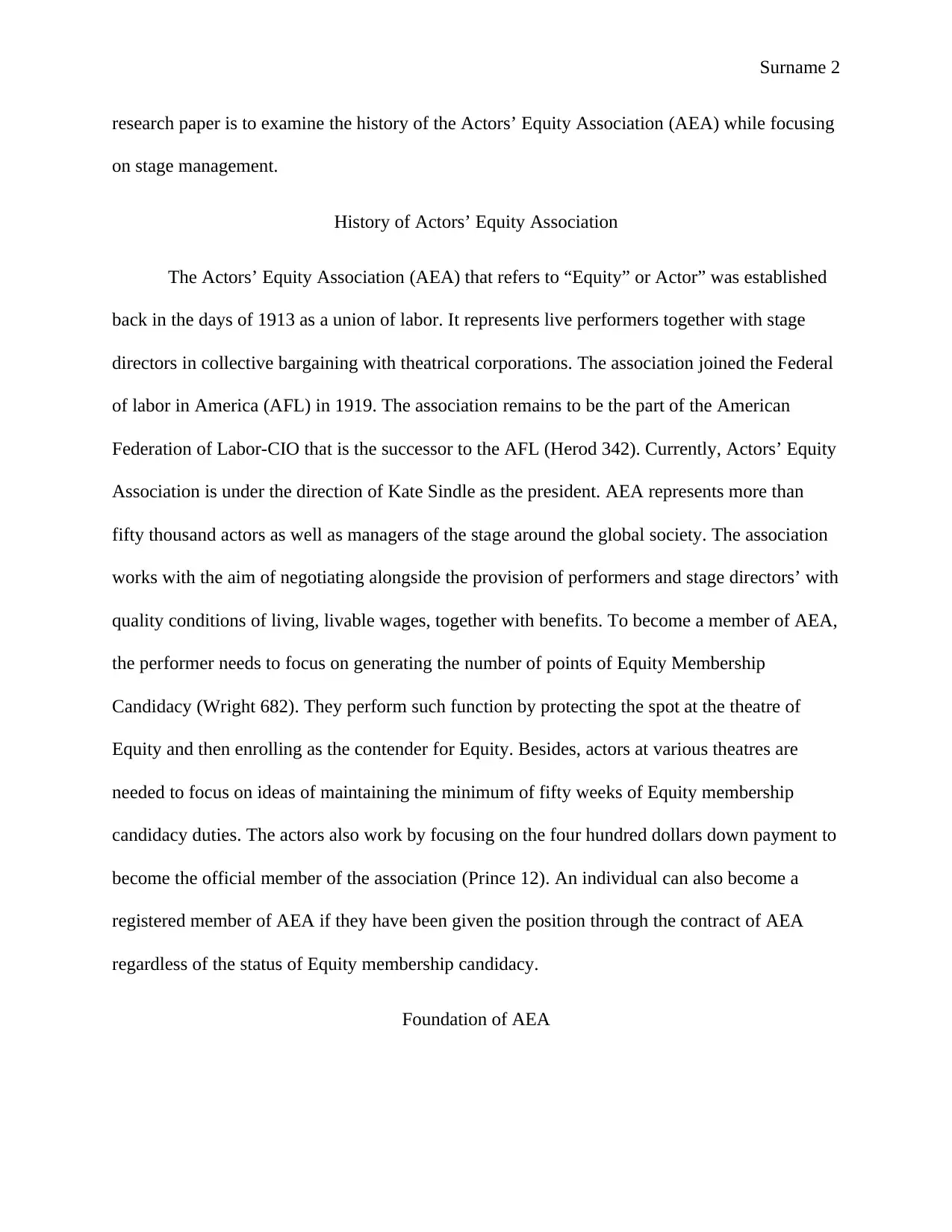
Surname 2
research paper is to examine the history of the Actors’ Equity Association (AEA) while focusing
on stage management.
History of Actors’ Equity Association
The Actors’ Equity Association (AEA) that refers to “Equity” or Actor” was established
back in the days of 1913 as a union of labor. It represents live performers together with stage
directors in collective bargaining with theatrical corporations. The association joined the Federal
of labor in America (AFL) in 1919. The association remains to be the part of the American
Federation of Labor-CIO that is the successor to the AFL (Herod 342). Currently, Actors’ Equity
Association is under the direction of Kate Sindle as the president. AEA represents more than
fifty thousand actors as well as managers of the stage around the global society. The association
works with the aim of negotiating alongside the provision of performers and stage directors’ with
quality conditions of living, livable wages, together with benefits. To become a member of AEA,
the performer needs to focus on generating the number of points of Equity Membership
Candidacy (Wright 682). They perform such function by protecting the spot at the theatre of
Equity and then enrolling as the contender for Equity. Besides, actors at various theatres are
needed to focus on ideas of maintaining the minimum of fifty weeks of Equity membership
candidacy duties. The actors also work by focusing on the four hundred dollars down payment to
become the official member of the association (Prince 12). An individual can also become a
registered member of AEA if they have been given the position through the contract of AEA
regardless of the status of Equity membership candidacy.
Foundation of AEA
research paper is to examine the history of the Actors’ Equity Association (AEA) while focusing
on stage management.
History of Actors’ Equity Association
The Actors’ Equity Association (AEA) that refers to “Equity” or Actor” was established
back in the days of 1913 as a union of labor. It represents live performers together with stage
directors in collective bargaining with theatrical corporations. The association joined the Federal
of labor in America (AFL) in 1919. The association remains to be the part of the American
Federation of Labor-CIO that is the successor to the AFL (Herod 342). Currently, Actors’ Equity
Association is under the direction of Kate Sindle as the president. AEA represents more than
fifty thousand actors as well as managers of the stage around the global society. The association
works with the aim of negotiating alongside the provision of performers and stage directors’ with
quality conditions of living, livable wages, together with benefits. To become a member of AEA,
the performer needs to focus on generating the number of points of Equity Membership
Candidacy (Wright 682). They perform such function by protecting the spot at the theatre of
Equity and then enrolling as the contender for Equity. Besides, actors at various theatres are
needed to focus on ideas of maintaining the minimum of fifty weeks of Equity membership
candidacy duties. The actors also work by focusing on the four hundred dollars down payment to
become the official member of the association (Prince 12). An individual can also become a
registered member of AEA if they have been given the position through the contract of AEA
regardless of the status of Equity membership candidacy.
Foundation of AEA
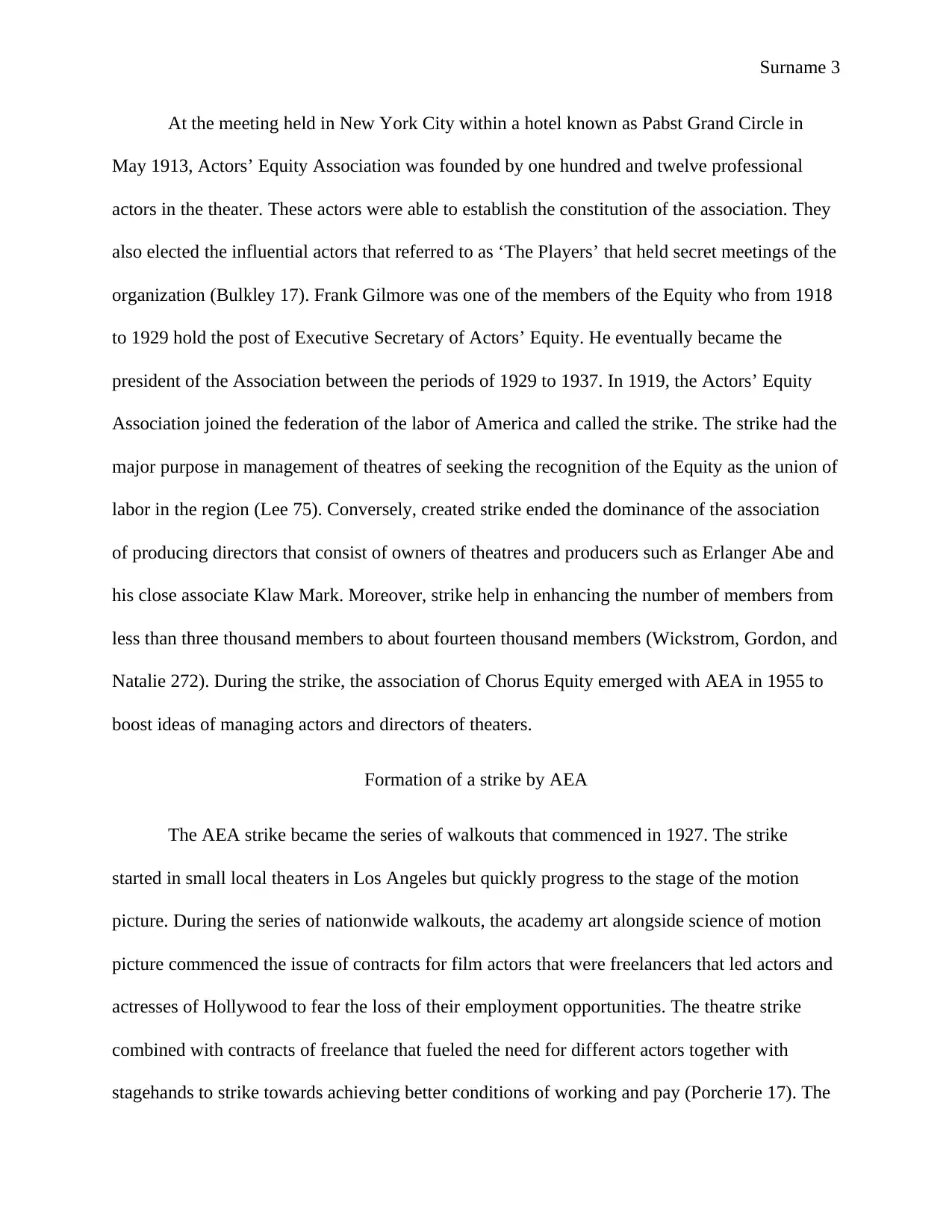
Surname 3
At the meeting held in New York City within a hotel known as Pabst Grand Circle in
May 1913, Actors’ Equity Association was founded by one hundred and twelve professional
actors in the theater. These actors were able to establish the constitution of the association. They
also elected the influential actors that referred to as ‘The Players’ that held secret meetings of the
organization (Bulkley 17). Frank Gilmore was one of the members of the Equity who from 1918
to 1929 hold the post of Executive Secretary of Actors’ Equity. He eventually became the
president of the Association between the periods of 1929 to 1937. In 1919, the Actors’ Equity
Association joined the federation of the labor of America and called the strike. The strike had the
major purpose in management of theatres of seeking the recognition of the Equity as the union of
labor in the region (Lee 75). Conversely, created strike ended the dominance of the association
of producing directors that consist of owners of theatres and producers such as Erlanger Abe and
his close associate Klaw Mark. Moreover, strike help in enhancing the number of members from
less than three thousand members to about fourteen thousand members (Wickstrom, Gordon, and
Natalie 272). During the strike, the association of Chorus Equity emerged with AEA in 1955 to
boost ideas of managing actors and directors of theaters.
Formation of a strike by AEA
The AEA strike became the series of walkouts that commenced in 1927. The strike
started in small local theaters in Los Angeles but quickly progress to the stage of the motion
picture. During the series of nationwide walkouts, the academy art alongside science of motion
picture commenced the issue of contracts for film actors that were freelancers that led actors and
actresses of Hollywood to fear the loss of their employment opportunities. The theatre strike
combined with contracts of freelance that fueled the need for different actors together with
stagehands to strike towards achieving better conditions of working and pay (Porcherie 17). The
At the meeting held in New York City within a hotel known as Pabst Grand Circle in
May 1913, Actors’ Equity Association was founded by one hundred and twelve professional
actors in the theater. These actors were able to establish the constitution of the association. They
also elected the influential actors that referred to as ‘The Players’ that held secret meetings of the
organization (Bulkley 17). Frank Gilmore was one of the members of the Equity who from 1918
to 1929 hold the post of Executive Secretary of Actors’ Equity. He eventually became the
president of the Association between the periods of 1929 to 1937. In 1919, the Actors’ Equity
Association joined the federation of the labor of America and called the strike. The strike had the
major purpose in management of theatres of seeking the recognition of the Equity as the union of
labor in the region (Lee 75). Conversely, created strike ended the dominance of the association
of producing directors that consist of owners of theatres and producers such as Erlanger Abe and
his close associate Klaw Mark. Moreover, strike help in enhancing the number of members from
less than three thousand members to about fourteen thousand members (Wickstrom, Gordon, and
Natalie 272). During the strike, the association of Chorus Equity emerged with AEA in 1955 to
boost ideas of managing actors and directors of theaters.
Formation of a strike by AEA
The AEA strike became the series of walkouts that commenced in 1927. The strike
started in small local theaters in Los Angeles but quickly progress to the stage of the motion
picture. During the series of nationwide walkouts, the academy art alongside science of motion
picture commenced the issue of contracts for film actors that were freelancers that led actors and
actresses of Hollywood to fear the loss of their employment opportunities. The theatre strike
combined with contracts of freelance that fueled the need for different actors together with
stagehands to strike towards achieving better conditions of working and pay (Porcherie 17). The
⊘ This is a preview!⊘
Do you want full access?
Subscribe today to unlock all pages.

Trusted by 1+ million students worldwide
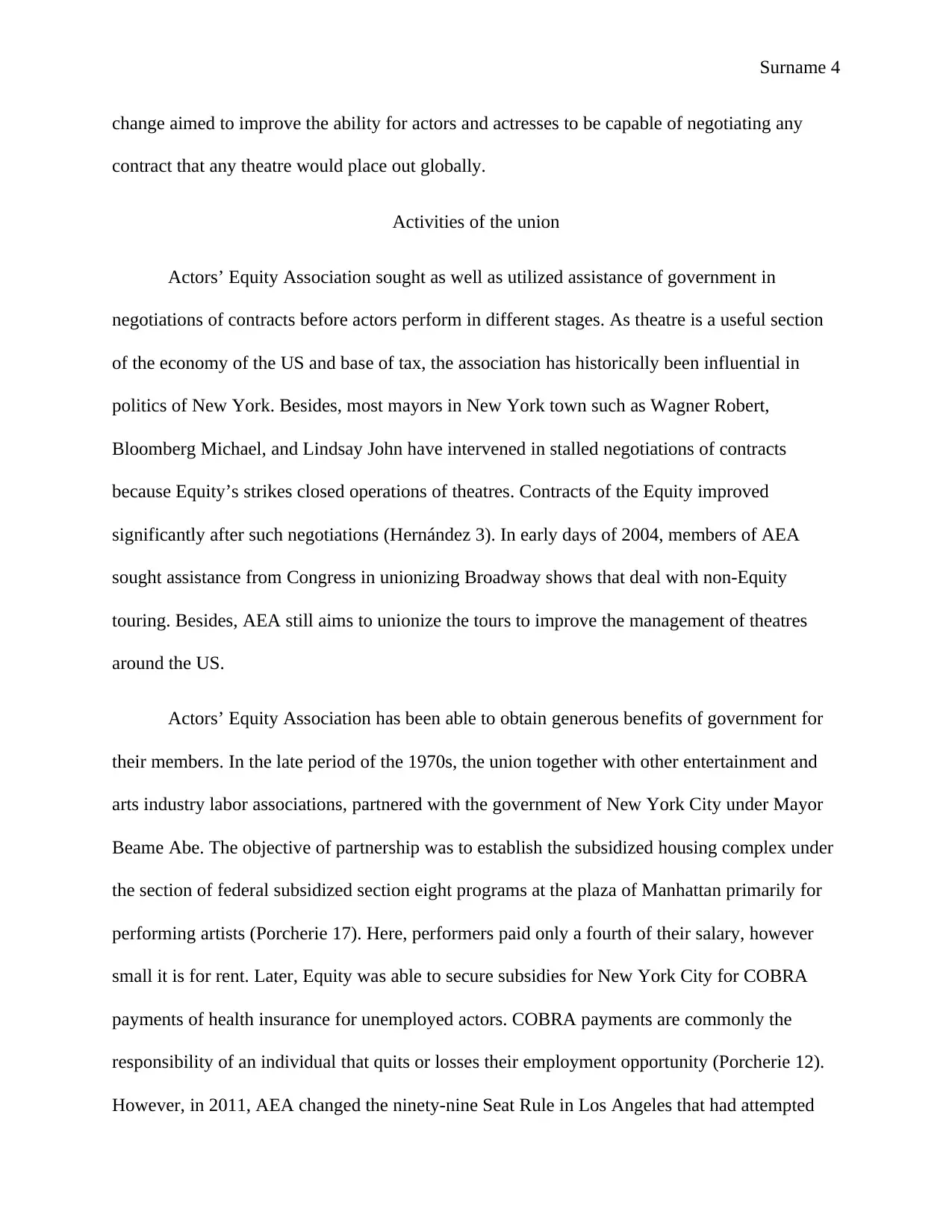
Surname 4
change aimed to improve the ability for actors and actresses to be capable of negotiating any
contract that any theatre would place out globally.
Activities of the union
Actors’ Equity Association sought as well as utilized assistance of government in
negotiations of contracts before actors perform in different stages. As theatre is a useful section
of the economy of the US and base of tax, the association has historically been influential in
politics of New York. Besides, most mayors in New York town such as Wagner Robert,
Bloomberg Michael, and Lindsay John have intervened in stalled negotiations of contracts
because Equity’s strikes closed operations of theatres. Contracts of the Equity improved
significantly after such negotiations (Hernández 3). In early days of 2004, members of AEA
sought assistance from Congress in unionizing Broadway shows that deal with non-Equity
touring. Besides, AEA still aims to unionize the tours to improve the management of theatres
around the US.
Actors’ Equity Association has been able to obtain generous benefits of government for
their members. In the late period of the 1970s, the union together with other entertainment and
arts industry labor associations, partnered with the government of New York City under Mayor
Beame Abe. The objective of partnership was to establish the subsidized housing complex under
the section of federal subsidized section eight programs at the plaza of Manhattan primarily for
performing artists (Porcherie 17). Here, performers paid only a fourth of their salary, however
small it is for rent. Later, Equity was able to secure subsidies for New York City for COBRA
payments of health insurance for unemployed actors. COBRA payments are commonly the
responsibility of an individual that quits or losses their employment opportunity (Porcherie 12).
However, in 2011, AEA changed the ninety-nine Seat Rule in Los Angeles that had attempted
change aimed to improve the ability for actors and actresses to be capable of negotiating any
contract that any theatre would place out globally.
Activities of the union
Actors’ Equity Association sought as well as utilized assistance of government in
negotiations of contracts before actors perform in different stages. As theatre is a useful section
of the economy of the US and base of tax, the association has historically been influential in
politics of New York. Besides, most mayors in New York town such as Wagner Robert,
Bloomberg Michael, and Lindsay John have intervened in stalled negotiations of contracts
because Equity’s strikes closed operations of theatres. Contracts of the Equity improved
significantly after such negotiations (Hernández 3). In early days of 2004, members of AEA
sought assistance from Congress in unionizing Broadway shows that deal with non-Equity
touring. Besides, AEA still aims to unionize the tours to improve the management of theatres
around the US.
Actors’ Equity Association has been able to obtain generous benefits of government for
their members. In the late period of the 1970s, the union together with other entertainment and
arts industry labor associations, partnered with the government of New York City under Mayor
Beame Abe. The objective of partnership was to establish the subsidized housing complex under
the section of federal subsidized section eight programs at the plaza of Manhattan primarily for
performing artists (Porcherie 17). Here, performers paid only a fourth of their salary, however
small it is for rent. Later, Equity was able to secure subsidies for New York City for COBRA
payments of health insurance for unemployed actors. COBRA payments are commonly the
responsibility of an individual that quits or losses their employment opportunity (Porcherie 12).
However, in 2011, AEA changed the ninety-nine Seat Rule in Los Angeles that had attempted
Paraphrase This Document
Need a fresh take? Get an instant paraphrase of this document with our AI Paraphraser
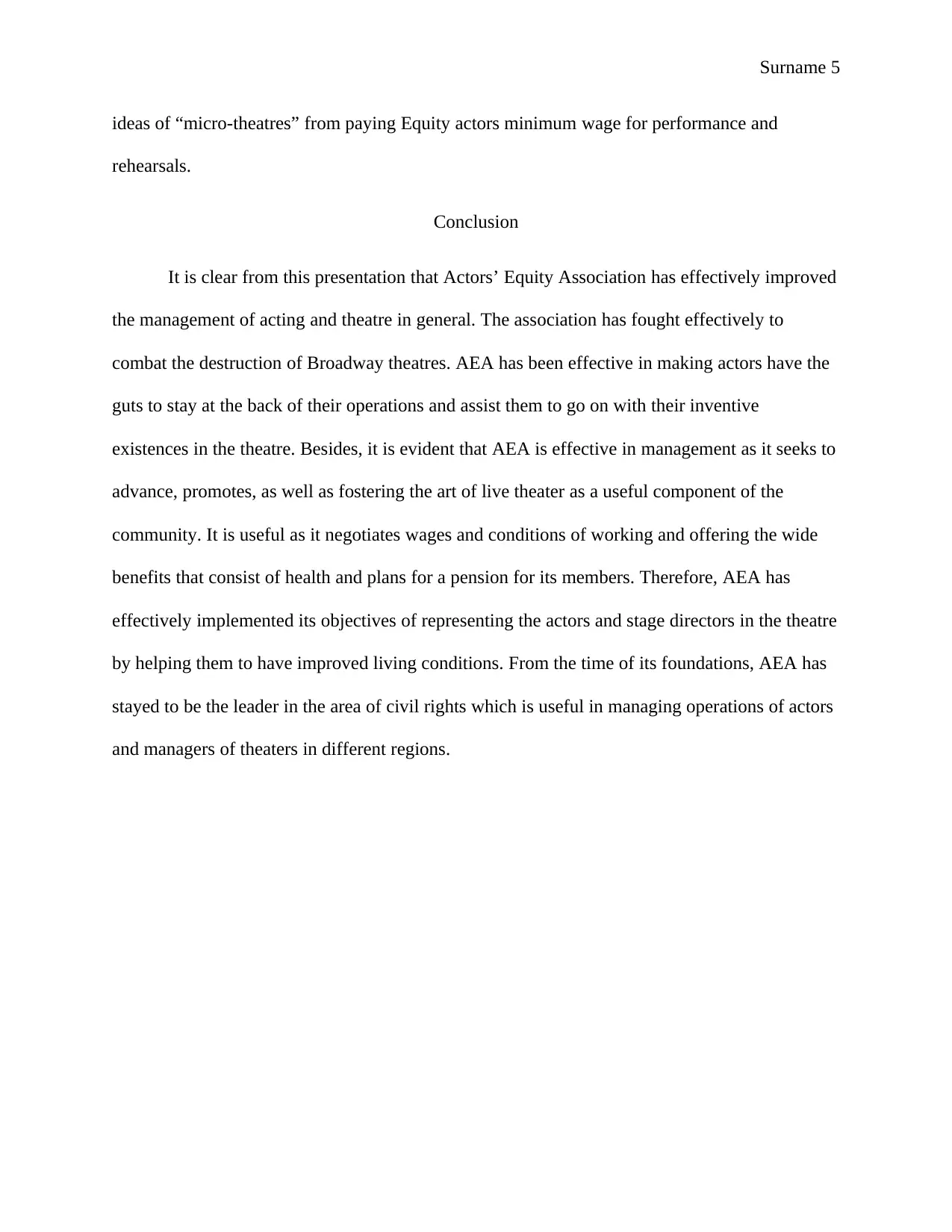
Surname 5
ideas of “micro-theatres” from paying Equity actors minimum wage for performance and
rehearsals.
Conclusion
It is clear from this presentation that Actors’ Equity Association has effectively improved
the management of acting and theatre in general. The association has fought effectively to
combat the destruction of Broadway theatres. AEA has been effective in making actors have the
guts to stay at the back of their operations and assist them to go on with their inventive
existences in the theatre. Besides, it is evident that AEA is effective in management as it seeks to
advance, promotes, as well as fostering the art of live theater as a useful component of the
community. It is useful as it negotiates wages and conditions of working and offering the wide
benefits that consist of health and plans for a pension for its members. Therefore, AEA has
effectively implemented its objectives of representing the actors and stage directors in the theatre
by helping them to have improved living conditions. From the time of its foundations, AEA has
stayed to be the leader in the area of civil rights which is useful in managing operations of actors
and managers of theaters in different regions.
ideas of “micro-theatres” from paying Equity actors minimum wage for performance and
rehearsals.
Conclusion
It is clear from this presentation that Actors’ Equity Association has effectively improved
the management of acting and theatre in general. The association has fought effectively to
combat the destruction of Broadway theatres. AEA has been effective in making actors have the
guts to stay at the back of their operations and assist them to go on with their inventive
existences in the theatre. Besides, it is evident that AEA is effective in management as it seeks to
advance, promotes, as well as fostering the art of live theater as a useful component of the
community. It is useful as it negotiates wages and conditions of working and offering the wide
benefits that consist of health and plans for a pension for its members. Therefore, AEA has
effectively implemented its objectives of representing the actors and stage directors in the theatre
by helping them to have improved living conditions. From the time of its foundations, AEA has
stayed to be the leader in the area of civil rights which is useful in managing operations of actors
and managers of theaters in different regions.
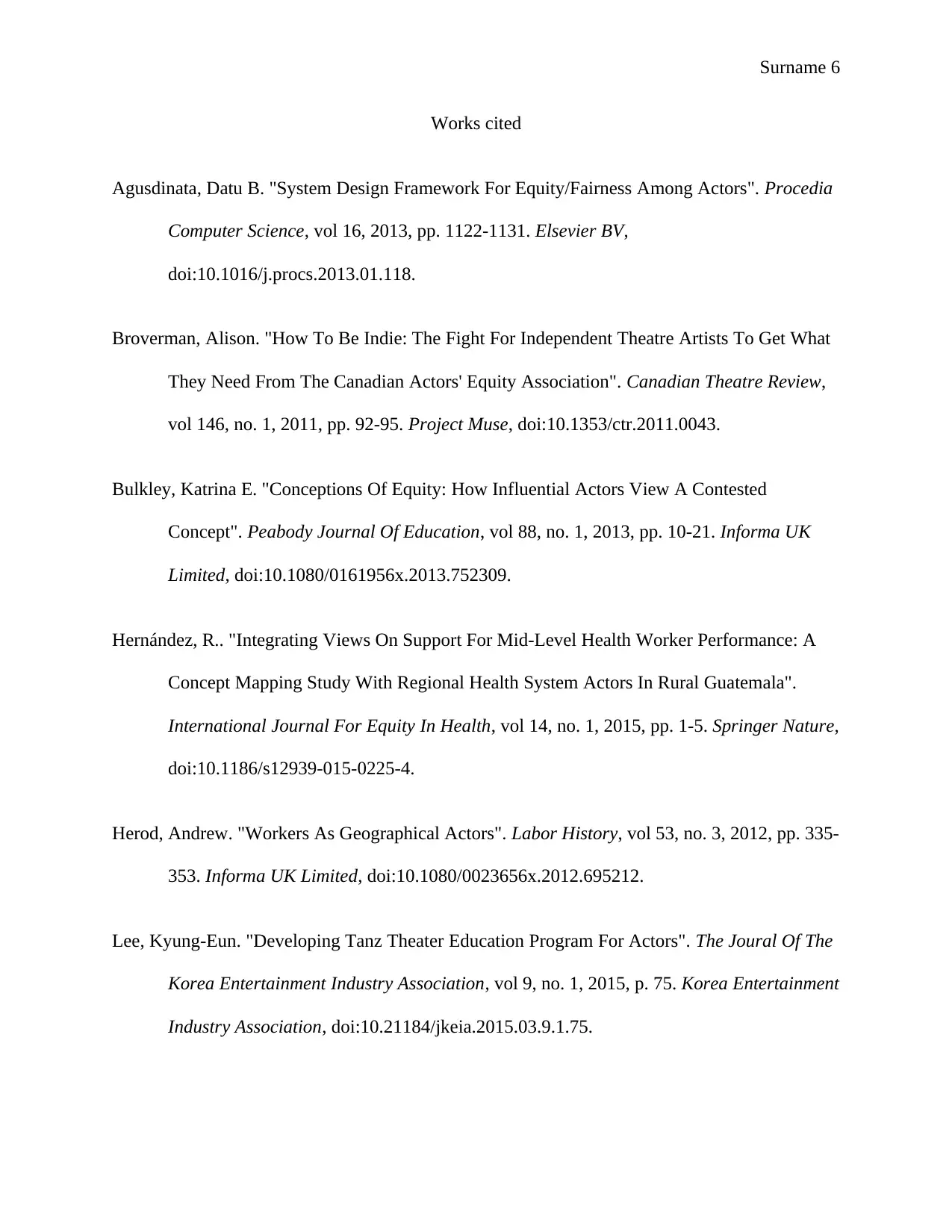
Surname 6
Works cited
Agusdinata, Datu B. "System Design Framework For Equity/Fairness Among Actors". Procedia
Computer Science, vol 16, 2013, pp. 1122-1131. Elsevier BV,
doi:10.1016/j.procs.2013.01.118.
Broverman, Alison. "How To Be Indie: The Fight For Independent Theatre Artists To Get What
They Need From The Canadian Actors' Equity Association". Canadian Theatre Review,
vol 146, no. 1, 2011, pp. 92-95. Project Muse, doi:10.1353/ctr.2011.0043.
Bulkley, Katrina E. "Conceptions Of Equity: How Influential Actors View A Contested
Concept". Peabody Journal Of Education, vol 88, no. 1, 2013, pp. 10-21. Informa UK
Limited, doi:10.1080/0161956x.2013.752309.
Hernández, R.. "Integrating Views On Support For Mid-Level Health Worker Performance: A
Concept Mapping Study With Regional Health System Actors In Rural Guatemala".
International Journal For Equity In Health, vol 14, no. 1, 2015, pp. 1-5. Springer Nature,
doi:10.1186/s12939-015-0225-4.
Herod, Andrew. "Workers As Geographical Actors". Labor History, vol 53, no. 3, 2012, pp. 335-
353. Informa UK Limited, doi:10.1080/0023656x.2012.695212.
Lee, Kyung-Eun. "Developing Tanz Theater Education Program For Actors". The Joural Of The
Korea Entertainment Industry Association, vol 9, no. 1, 2015, p. 75. Korea Entertainment
Industry Association, doi:10.21184/jkeia.2015.03.9.1.75.
Works cited
Agusdinata, Datu B. "System Design Framework For Equity/Fairness Among Actors". Procedia
Computer Science, vol 16, 2013, pp. 1122-1131. Elsevier BV,
doi:10.1016/j.procs.2013.01.118.
Broverman, Alison. "How To Be Indie: The Fight For Independent Theatre Artists To Get What
They Need From The Canadian Actors' Equity Association". Canadian Theatre Review,
vol 146, no. 1, 2011, pp. 92-95. Project Muse, doi:10.1353/ctr.2011.0043.
Bulkley, Katrina E. "Conceptions Of Equity: How Influential Actors View A Contested
Concept". Peabody Journal Of Education, vol 88, no. 1, 2013, pp. 10-21. Informa UK
Limited, doi:10.1080/0161956x.2013.752309.
Hernández, R.. "Integrating Views On Support For Mid-Level Health Worker Performance: A
Concept Mapping Study With Regional Health System Actors In Rural Guatemala".
International Journal For Equity In Health, vol 14, no. 1, 2015, pp. 1-5. Springer Nature,
doi:10.1186/s12939-015-0225-4.
Herod, Andrew. "Workers As Geographical Actors". Labor History, vol 53, no. 3, 2012, pp. 335-
353. Informa UK Limited, doi:10.1080/0023656x.2012.695212.
Lee, Kyung-Eun. "Developing Tanz Theater Education Program For Actors". The Joural Of The
Korea Entertainment Industry Association, vol 9, no. 1, 2015, p. 75. Korea Entertainment
Industry Association, doi:10.21184/jkeia.2015.03.9.1.75.
⊘ This is a preview!⊘
Do you want full access?
Subscribe today to unlock all pages.

Trusted by 1+ million students worldwide
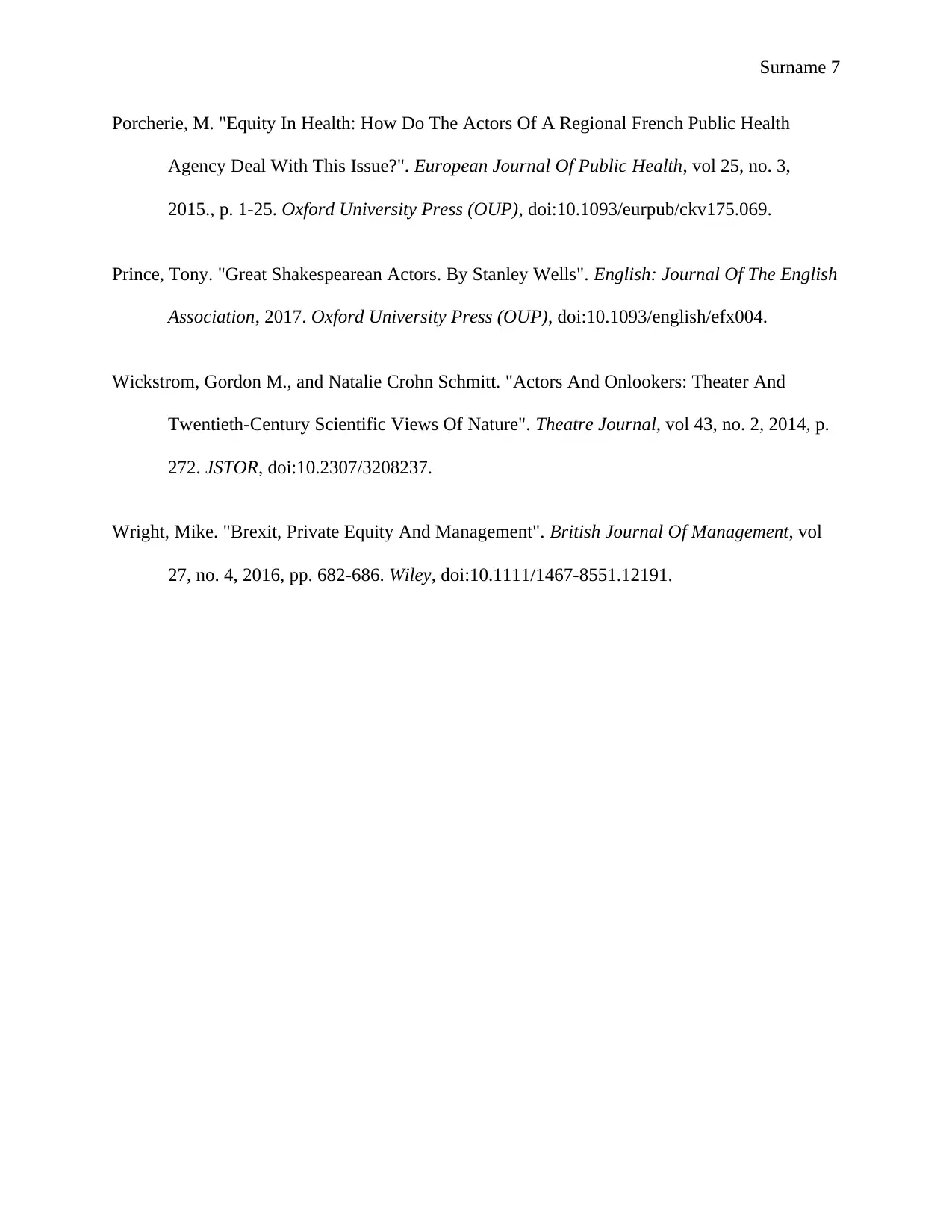
Surname 7
Porcherie, M. "Equity In Health: How Do The Actors Of A Regional French Public Health
Agency Deal With This Issue?". European Journal Of Public Health, vol 25, no. 3,
2015., p. 1-25. Oxford University Press (OUP), doi:10.1093/eurpub/ckv175.069.
Prince, Tony. "Great Shakespearean Actors. By Stanley Wells". English: Journal Of The English
Association, 2017. Oxford University Press (OUP), doi:10.1093/english/efx004.
Wickstrom, Gordon M., and Natalie Crohn Schmitt. "Actors And Onlookers: Theater And
Twentieth-Century Scientific Views Of Nature". Theatre Journal, vol 43, no. 2, 2014, p.
272. JSTOR, doi:10.2307/3208237.
Wright, Mike. "Brexit, Private Equity And Management". British Journal Of Management, vol
27, no. 4, 2016, pp. 682-686. Wiley, doi:10.1111/1467-8551.12191.
Porcherie, M. "Equity In Health: How Do The Actors Of A Regional French Public Health
Agency Deal With This Issue?". European Journal Of Public Health, vol 25, no. 3,
2015., p. 1-25. Oxford University Press (OUP), doi:10.1093/eurpub/ckv175.069.
Prince, Tony. "Great Shakespearean Actors. By Stanley Wells". English: Journal Of The English
Association, 2017. Oxford University Press (OUP), doi:10.1093/english/efx004.
Wickstrom, Gordon M., and Natalie Crohn Schmitt. "Actors And Onlookers: Theater And
Twentieth-Century Scientific Views Of Nature". Theatre Journal, vol 43, no. 2, 2014, p.
272. JSTOR, doi:10.2307/3208237.
Wright, Mike. "Brexit, Private Equity And Management". British Journal Of Management, vol
27, no. 4, 2016, pp. 682-686. Wiley, doi:10.1111/1467-8551.12191.
1 out of 7
Your All-in-One AI-Powered Toolkit for Academic Success.
+13062052269
info@desklib.com
Available 24*7 on WhatsApp / Email
![[object Object]](/_next/static/media/star-bottom.7253800d.svg)
Unlock your academic potential
Copyright © 2020–2025 A2Z Services. All Rights Reserved. Developed and managed by ZUCOL.